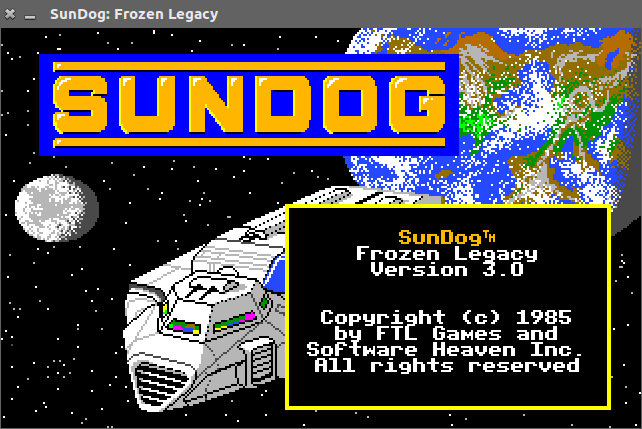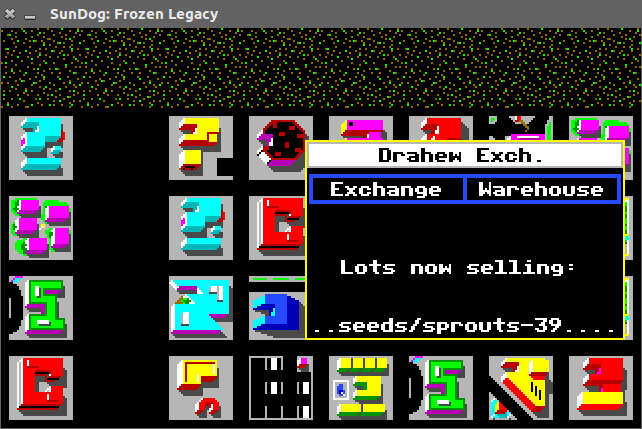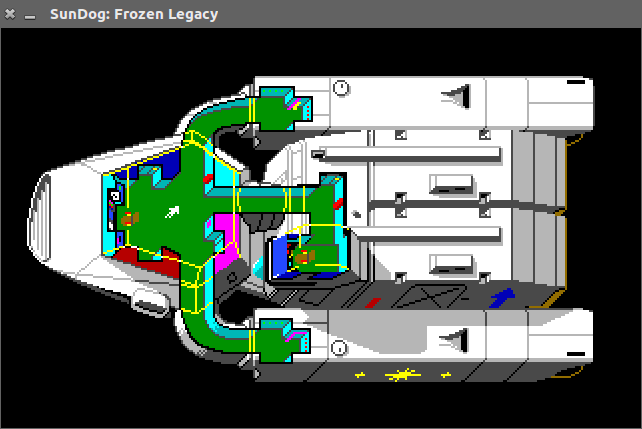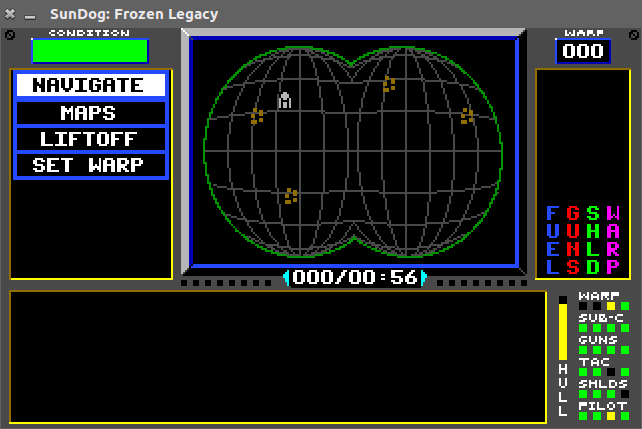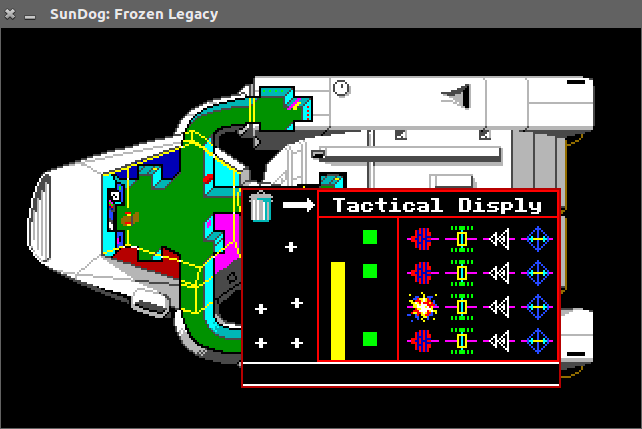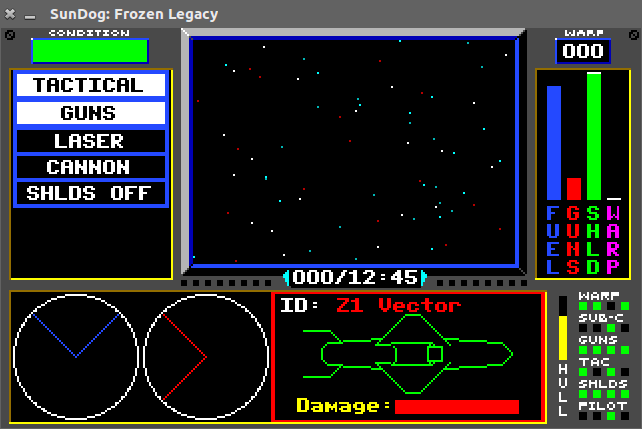laanwj / Sundog
Projects that are alternatives of or similar to Sundog
Sundog: Frozen Legacy

This is a port of the Atari ST game SunDog: Frozen Legacy (1985) by FTL software to modern platforms, using SDL2 for input and OpenGL ES 2 for graphics. A good overview of the gameplay can be found on wikipedia.
The game was originally written in Pascal, developed using the well-known UCSD Pascal compiler. This compiler compiles to bytecode called "p-code" for an abstract architecture called the p-system. This project implements a p-system interpreter (also called "P-Machine Emulator" or PME) in C, which is able to run the game.
This makes it possible to run the game without emulating the Atari ST or even 68000 processor. There are a few assembly-language functions for (primarily) graphics rendering, which have been re-implemented separately.
The goal of this port is to keep the gameplay and graphics close to the Atari ST version, although small hacks or improvements would be welcome. See the Sundog Resurrection project for a complete re-imagining of the game.
Screenshots
Disk image
For copyright reasons this game does not come with the resources nor game code.
It requires the user to provide a 360K .st raw disk image of the game to run.
This can be imaged from an original copy or found on a dozen abandonware sites.
Be sure to use an image of the original disk: the re-packed version will not
work as the layout of the disk will be different.
Unlike the original game which writes to disk on every start, this implementation never writes to the disk image.
Building from source
To build from source make sure the SDL2 development package for your distribution is installed, the OpenGL ES 2 headers, as well as GNU readline (only necessary for the debugger). On Ubuntu this is:
apt-get install libreadline-dev libsdl2-dev libgles2-mesa-dev
Then:
cd src
make
Invocation
To run, you'll need a graphics driver as well as hardware capable of supporting OpenGL ES 2.0. This is pretty much the lowest common denominator for graphics rendering these days.
The game can be started using the command line:
./sundog <image.st>
Where <image.st> is the Sundog disk image to use.
Playing
After starting the program the game will immediately start.
Lots of hints for playing the game, as well as the original manual can be found on the excellent Sundog information page.
Key shortcuts
The game is controlled with the mouse only. There are however some key shortcuts for the interpreter:
-
Pause/unpause game -
sSave state tosundog.savin current directory. -
lLoad state fromsundog.savin current directory.
Some other shortcuts are debugging related, see debugging.md.
Status
What works?
- Loading screen graphics, palette effects.
- Starting a new game.
- Right-click popup in-game.
- Walking around the ship and in buildings.
- Liftoff / Landing.
- Sublight flight.
- Warp (albeit without fancy effects).
- Loading / reading save states (
landsrespectively). - Ground combat.
- Space combat.
- Touch screen support: a small area in the top-right of the screen has been designated as "cancel area" and will emulate a right-mouse click when touched.
Is it fully playable? Yes, I played it for quite a bit. All the critical things have been implemented, Though I cannot guarantee that there aren't any bugs left. If so, please report them through the issue tracker, along with a saved state if possible.
To be done
Non-critical:
- Sound: as the game uses XBIOS DoSound call for sound, this would involve emulating the YM2149F PSG sound chip, at least up to a point (or as there seems to be a fixed number of 36 sound effects: substituting sampled sounds).
- Initial FTL animation is missing: this is an assembly routine that triggers before the bootstrapping of the p-machine.
- Not all of the stuff in SHIPLIB has been implemented. There are four native procedures in this segment (0x16, 0x18, 0x19, 0x1a) which seem to be rendering effects for the ship the viewscreen (stars, explosion, fire weapon animation, warp animation respectively). There seems to be no further user interaction code. Only the warp animation is completely not implemented at this time, the others are at least able-enough placeholders.
Future ideas
The input for this game is mouse-only, it takes mouse position and two-buttons state. The screen resolution is only 320×200 (doubled to 640×400). This makes it ideally suited for touch screen. An Android port of this would be would be fantastic.
P-system
Sundog uses version IV.2.1 R3.4 of the p-system. This is a version of the
p-system developed commercially by Softech. I looked at using ucsd-psystem-vm,
however this implements version II.0 which is significantly different. As
far as I know this is the only open source, publicly available p-system
IV implementation. It is fairly independent of the game, so if it is useful
for anything else it could be factored out to a library. Code for the p-system
interpreter is in src/psys.
The p-system has a custom disk layout (this is why on the Atari ST the disk
looks like it has only a small .prg and the rest of the disk is empty). This
layout is very basic: it supports only contiguous files, and there is only
the top-level directory.
P-code is stored in code files, which in turn are organized into segments. Segments are self-contained and can be compared to "units" in later Pascal variants. These in turn contain one or multiple procedures.
At bootstrap time the interpreter seeks into a code archive SYSTEM.PASCAL, loads
the segment USERPROG, and starts interpreting at procedure 1 of that segment.
From there the p-system takes care of the rest of initialization, eventually
executing SYSTEM.STARTUP. This is the game, in this case.
In modern terms the P-system is comparable to the Java Runtime Environment, but more low-level. Some "advanced" features (for the time) that are supported:
-
OS, architecture, endian-independent bytecode.
-
Tasks (multi-tasking), synchronized using semaphores.
-
External events (user input, timer interrupts) can signal semaphores.
-
Paging ("swapping") of code. Segments are loaded when accessed, causing a segment fault to occur. When there is memory pressure, least recently used code segments are discarded, and will be reloaded when used again.
-
Run-time error handling.
-
Dynamic memory management (the heap).
It most notably does NOT do:
-
Security and sandboxing. Everything can read and write everywhere.
-
Address more than 64KiB (or 128KiB on word-addressed architectures) of data memory. It does however use "code pools" to be able to store more code.
The game includes a rudimentary debugger (use d key to start it) which can be used to poke around in the internals of the p-machine.
The best overview of the internals of the p-system version IV is the "p-System Software Reference Library: Internal Architecture", which can be found on bitsavers.
Debug UI
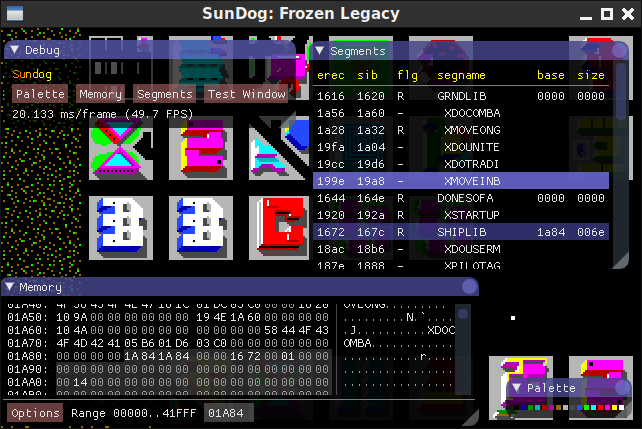
A debug UI can be compiled in to aid with debugging and reverse engineering. For more information, see debugging.md.
Credits
Authors:
- Wladimir J. van der Laan
Contributions in the form of github pull requests are very welcome.
Special thanks to:
- Bitsavers
- The UCSD pascal group on Yahoo
- ocornut for the "dear imgui" GUI system used for debug GUI
- Of course late FTL software: Bruce Webster, Doug Bell, Wayne Holder, Mike Newton, Andy Jaros for making SunDog in the first place.
License
This software is provided under the MIT license.

